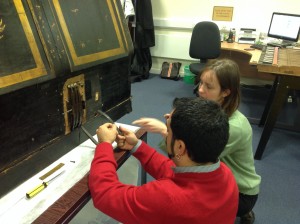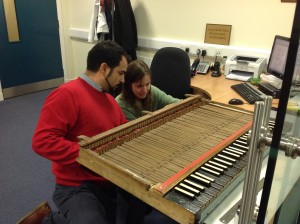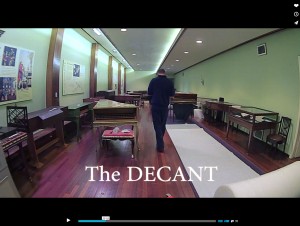Although St Cecilia’s Hall is closed to the public, it does not mean that the objects are placed in storage and left until they are reinstalled. Collection business still goes on with teaching and with visits from scholars who are researching instruments in the collection. This semester sees postgraduate teaching for the MMus Musical Instrument Research programme, which will concentrate on Keyboard Organology. For this class the appropriate instruments are removed from the storage shelves and made available for students to examine in detail.
As a leading international collection, with many iconic instruments, we have requests from visiting scholars to carry out research. Such visits are always informative for collection staff as well as the visitor. There is discourse in which aspects of research are discussed and often various theories are passed backwards and forwards in an attempt to get a fuller understanding of the object.
Although we need to respond in a different manner to research requests when the objects are stored in a location away from the staff, it is still an important part of the Collection’s work to further the creation and dissemination of knowledge.
We recently had a visit from the Belgian harpsichord maker and researcher Ellen Denolf, who wished to examine the knee lever mechanism of our Goermans/Taskin harpsichord. Certainly one of the best known instruments in the collection, it was built by Jean Goermans in 1764, and altered in 1783/4 by Pascal Taskin – the most important maker in late-eighteenth century Paris.
Taskin made a number of changes to the instrument. He added an extra register of jacks which were used to pluck the string with soft leather, providing a contrast to the harder bird quill. He also strengthened the framing inside the case – something the visitor never normally sees – had the instrument redecorated with chinoiserie on the exterior and lid interior and added knee levers in place of handstops. Players could then use the knees to get different sounds while continuing to play. One knee lever even allowed a diminuendo effect by reducing the sound from all of the quill registers to just the soft leather (known as peau de buffle).
The images show Ellen and MIMEd Conservator Jonathan Santa Maria Bouquet examining and discussing aspects of the knee lever mechanism at the instrument’s spine and the back of the keyboard.


It should be mentioned that Taskin perhaps didn’t do everything quite above board. Other work on the instrument included removing Goerman’s name from the soundboard, staining the whole soundboard and cutting the serif from the lead rose in the soundboard which normally displays the maker’s initials – in this case “IG”. By changing it to “IC” Taskin could perhaps pass the instrument off as being by Ioannes Couchet – a member of the famous Ruckers family whose instruments went for many times what a recent French example might sell for!


